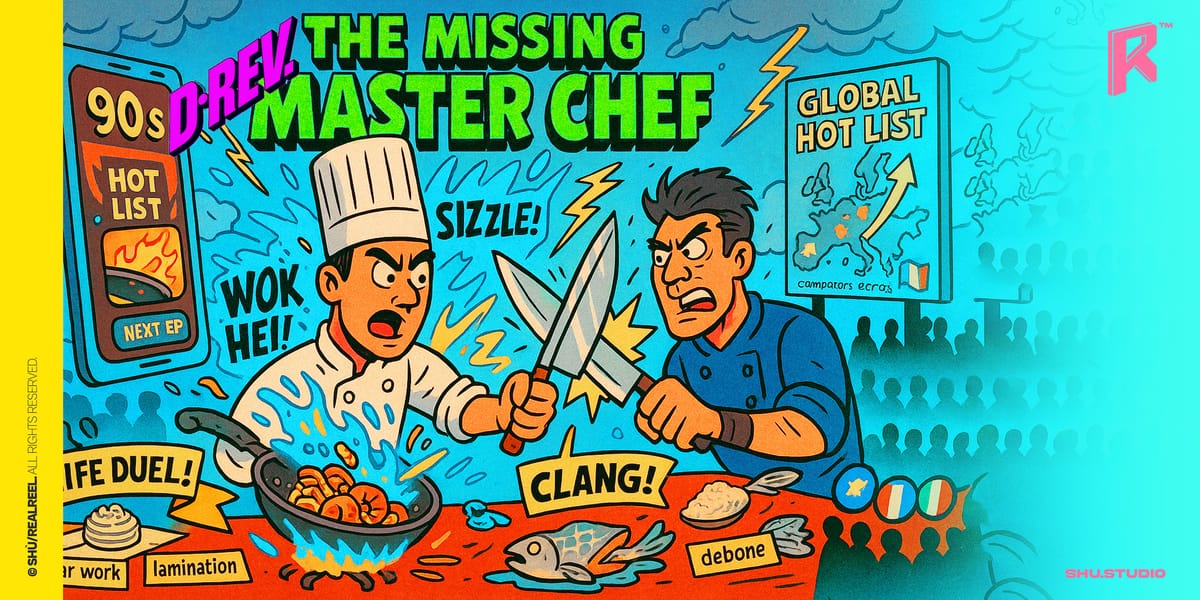Vertical Drama Review: The Missing Master Chef: when short-form drama turns Chinese cookery into myth

⚈ ⚈
A year after its October 2024 launch, The Missing Master Chef ⇲ is still hovering on the hot charts for vertical dramas: an unlikely long tail for a dubbed import built around Chinese cuisine.
Creator-first note: this is a craft-and-market read you can borrow from.
Join Real ReelA year after its October 2024 launch, The Missing Master Chef ⇲ is still hovering on the hot charts for vertical dramas: an unlikely long tail for a dubbed import built around Chinese cuisine.
The buy map skews unmistakably European; campaigns cluster across Portugal, Italy, Spain, France and Greece, with sturdy pockets in Germany, Romania, Ireland, Austria and the Netherlands. Distribution is classic performance media, social feeds and in-stream placements, yet the show plays bigger than its plumbing because it understands a simple truth:
food is a universal close-up, and technique is story.

What the series does, episode after ninety-second episode, is crown Chinese craft with drama. Knifework isn’t coverage; it’s a duel. Dough pulling is an oath. A flick of the wok becomes a question of honor and lineage. The writers stage each beat like a heist: first the promise of the finished plate, then a reversal that threatens it, then a narrow path through a single piece of know-how: sugar work, lamination, deboning, pushed to the edge of failure. It’s competence cinema compressed for the scroll, a rhythm of tease, technique and tiny cliff that keeps the thumb off the exit.
The show’s visual grammar is shameless and effective. Heat ripples are exaggerated, steel flashes ride a hair of light, and “wok hei” is rendered as a visible force field. None of it is expensive; sometimes it reads like bargain sparkle. But in a vertical frame the embellishments function as subtitles for physics. They tell a pan-continental audience, in three seconds, why this motion matters. The result is strangely educational without ever turning into a lesson. Ingredient callouts, pinyin or literal labels, macro shots of texture and timing: even muted, you can track what’s at stake.

Dubbing is the obvious seam. Lip timing wanders in places, and the English-language ADR can flatten a line that wants more bite. The series earns back credibility with tactile sound and cutting: the scrape, the toss, the scald, so the sensory reality undercuts the artifice. When the effects overstay their welcome, especially in certain plating shots, the spell can wobble; you see the composite before you see the food. Yet the show rarely loses momentum because the next challenge is always already cued.
Why Europe? Partly taste. The Mediterranean bloc recognizes itself in fire, oil, seafood and dough; the Central European crowd responds to precision and process. But it’s also how the series packages difference as delight. Fermentation rituals, knife geometries, sugar filigree, things that can feel niche on paper, arrive as pure screen action, stripped of lecture and loaded with stakes. You don’t need a glossary to know whether the move worked. Either the sugar threads catch the light, or they collapse. Either the bone yields clean, or it doesn’t. That binary reads in any language.
The structure is not bulletproof. Around the twenty-episode mark you can feel the template show through: the “technique → upgrade → reversal → triumph” loop wants a deeper well of character desire to keep surprising us. Whenever the writers tether a trick to something personal — reputation, a license on the line, a memory of a master, the series lifts. When it’s just effects over repetition, the magic thins. Still, for a format designed to be sampled between subway stops, the hit rate is high. The show understands that in short form, clarity is a kind of luxury: one action, one payoff, one reason to stay.
For creators eyeing cross-border travel, The Missing Master Chef ⇲is a clean case study. Treat craft as protagonist. Shoot steps like plot. Let visual emphasis amplify, not replace, physics. Offer the hero image early, then rewind into the how. Keep the copy local but the choreography legible. For platforms, the takeaway is distribution-agnostic: when you pair a recognizable universal (the pleasure of food) with a distinct cultural grammar (Chinese technique) and deliver it with reliable cadence, a dubbed show can sustain months on a hot list, exactly what this one has done since its 2024 bow.
The verdict is less about cuisine than about form. The Missing Master Chef turns kitchen work into a miniature action franchise, glossed with cardboard glitter and powered by real hands. It’s the kind of series algorithms love because audiences don’t just watch to see who wins, they watch to see if physics will cooperate. In 90 seconds, that’s a perfect question.
★★★☆☆






